 |
Distributed Solar Energy System
|
 |
Variability analysis of RE sources
Seasonal variability analysis is carried out, dividing the entire area into 3 regions, i.e. West coast, East coast and Interior taluks, depending upon the geography of the region. Figure 3 depicts the variation in solar insolation across the seasons for all 3 regions. Insolation reception is highly variable in monsoon and winter due to the cloud movements in all the regions. However, insolation is less variable during summer in all the regions and west coast shows lesser variability of insolation in all the seasons. Solar technologies have the potential to offset a huge volume of GHG emissions as demonstrated and help realize a low carbon economy at a faster rate. It will create numerous employment opportunities especially in the village level. Learning from other developing countries as well as its own past experiences, India can be a world leader in solar power generation. With an ambitious solar mission, and positively evolving policy instruments, the nation will rightly adorn the epithet of ‘Solar India’ in the near future. Decentralized generation of electricity through rooftop SPV would help in meeting the respective household’s electricity demand apart from the removal of T&D losses. Generation based incentives (GBI) would herald the decentralized electricity generation, which would help in boosting the regional economy. Considering the current level of T & D losses in centralized system, in-efficient and unreliable electricity supply, it is necessary to promote decentralized energy generation. Small capacity systems are efficient, economical and more importantly would meet the local electricity demand.
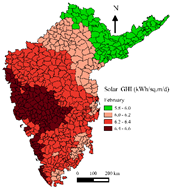
|
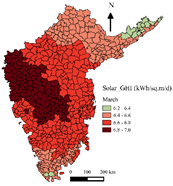
|
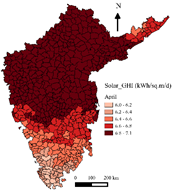
|
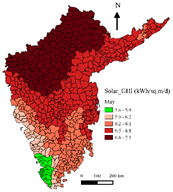
|
Summer (February to May) |
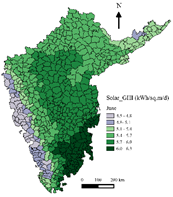
|
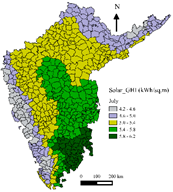
|
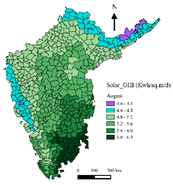
|
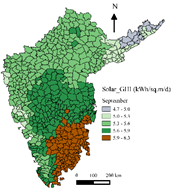
|
Monsoon (June to September) |
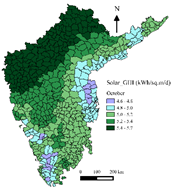
|
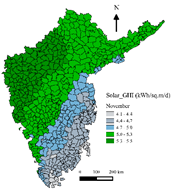
|
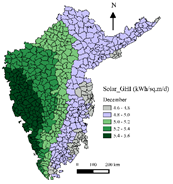
|
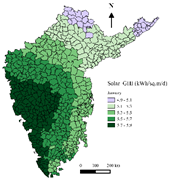
|
Winter (October to January) |
Fig.1. Taluk wise seasonal variation of solar energy potential
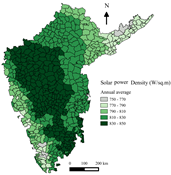
Fig.2. Taluk wise solar energy density distribution
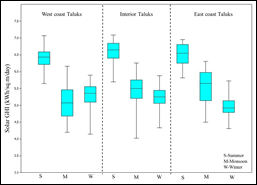
Fig. 3. Seasonal variability of solar energy potential
The incentives could be
-
Rs. 4.00 per unit for first five years (comparable to subsidies granted to mini hydro projects, the power purchase at Rs 3.40) and Rs. 3.50 for the next two years for the electricity generated from roof top solar PV. Recently federal governments (Karnataka, Tamil Nadu, Andhra Pradesh) have come out with a very attractive generation based incentive scheme, which has given boost to the dissemination of solar based systems.
-
Buyback programs for the electricity generated at household level and in micro grid - GBI of Rs. 5 to be provided for electricity generation (< 5 kW) feeding to the grid by SPV.
-
Install solar rooftops in all new government/local body buildings - implementation of solar rooftops could be in a phased manner in the existing government/local body buildings, etc.
-
Commercial lighting in advertisement boards should only be from RE sources. Complete ban on usage of grid electricity for these purposes.
-
Impetus to energy research through generous funding for the R and D activities to ensure further improvements in the grid, technologies, two way communication energy meters (to connect rooftop generation with existing grid), efficient luminaries’ production, low cost wiring, switchgears, appliances, etc.
-
Energy education (focusing mainly on renewable energy technologies, end-use energy efficiency improvements, energy conservation) at all levels. School curriculum shall include renewable energy (RE) concepts.
-
Awareness about energy independence and the necessity of RE sources in the present gloomy energy scenario to the consumers.
-
Education and awareness about applications and importance of renewable energy sources.
-
Capacity building of youth through technical education for installation and servicing of SPV panels.
-
Setting up service centers in block development offices to meet the requirement of service support for RE technologies (Solar, biogas, energy efficient chulas, etc.).
Smart Grid and New Energy Sources:
Smart grid is an intelligent system (manual/automated) which integrates all components of the power system (generator, transmission and distribution network, end users) for reliable, efficient and environmental friendly energy supply. It also plays a key role in demand response, peak load management, unit commitment and to have effective renewable mix in the installed capacity. Well established information and communication technology (ICT) and control networks are the backbone of smart grid for which the supportive grid network is required [20, 21]. Power sector in India is evolving and adopting modern grid technologies such as supervisory control and data acquisition (SCADA), energy management system (EMS), distribution automation (DA), advanced metering infrastructure (AMI) such as prepaid meters etc. However, the communication network is limited to high voltage transmission equipment and feeble parts of the present power network needs to be strengthened to have the smart grid architecture. India is planning to have a full phase smart grid by 2025, for which required devices such as FACT (flexible AC transmission) controllers and phasor measurements units (PMUs) are being installed. Around 14 pilot projects are being implemented by Indian Government under Restructured Accelerated Power Development and Reforms Program (R-APDRP) and the US-India Partnership to Advance Clean Energy-Development (PACE-D) programs. Data management technologies and automatic screening of data, collected through remote terminal units (RTUs) is the worldwide challenge to make the network smart and to take quick decisions (ISGTF 2013). However, smart grid is vision, a revolutionary change in the power sector which requires contributions from industry, academic and research institutions. Smart grid architecture varies from place to place and essentially depends on the present grid structure, load dynamics and resource availability. Indian power sector still suffers from huge unmet demand due to lack of peak load management and high T & D losses. Smart grid would primarily reduce the network losses and narrow the energy demand gap. Power sector should be analysed considering future demand and then the grid architecture should be decided, whereas replicating the smart grid architecture may not be the solution. This demands a radical government policies focusing on renewable energy, revolutionary improvements in end-use technologies and changes in the resource utilization practices. Nevertheless, current trend of consumption of fossil fuel resources have caused many environmental problems necessitating re-structuring of energy portfolio
Citation :Ramachandra TV and Ganesh Hedge,(2016). Distributed Solar Energy System, January-February 2016, pp.34-39.
|
|
Dr. T.V. Ramachandra
Centre for Sustainable Technologies, Centre for infrastructure, Sustainable Transportation and Urban Planning (C iSTUP),
Energy & Wetlands Research Group, Centre for Ecological Sciences, Indian Institute of Science, Bangalore – 560 012, INDIA.
E-mail : cestvr@ces.iisc.ac.in
Tel: 91-080-22933099/22933503 (extn 107)
Fax: 91-080-23601428/23600085
Web: http://ces.iisc.ac.in/energy
Ganesh HagdeEnergy and Wetlands Research Group, Centre for Ecological Sciences, Indian Institute of Science, Bangalore – 560012, India
E-mail: ganesh@ces.iisc.ac.in
Citation:Ramachandra TV and Ganesh Hedge,(2016). Distributed Solar Energy System, January-February 2016, pp.34-39.
|















